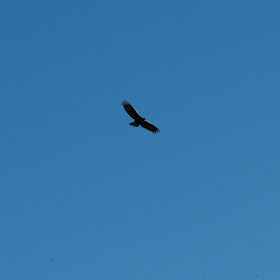When the sun is shining it is difficult to stay indoors. I went back to Black Park to photograph the Devil's Bit Scabious again. Typically I didn't have a long lens on to capture one of the Golden Eagles enjoying the thermals!
The evening light on the Treshnish cottages when I walked home was lovely and Shian's guests were enjoying the changing sky as the sun was planning its sunset.
Dense Devil's Bit Scabious is vital for the Marsh Fritillary butterfly. It is its SOLE feed plant.
Cattle are vital for the maintenance of the habitat in the right condition to allow both species to flourish. The correct density of the plant. The correct sward height. The correct tussockyness. But I was unsure as to what time of year we need to have these correct details...
This patch of scabious is in an area fenced off for trees, hence the long grass surrounding it as it is not grazed at all.
Yesterday I went over to Oban to attend a Marsh Fritillary Butterfly workshop run by Tom Prescott (below) from Butterfly Conservation Scotland. Butterfly Conservation are trying to monitor the Marsh Frit in Scotland. They have ongoing monitoring in England and Ireland but not here. This makes it impossible to know whether they are on the increase or not. Tom Brereton, Head of Monitoring, had come up from Dorset so along with Tom Prescott, we had the best tutors!
We spent the wet part of the day indoors (the morning) in Oban. We learned more about the butterfly itself, and about the importance and methodology of monitoring. Before the workshop I was unclear about their life cycle and if we are to attract them to our fields, what our habitats need to be like at the various times in their life cycle.
After our packed lunches we headed out into the field. It always astonishes me how just a mile or two away from Oban, you can be in stunning landscape with fabulous views, peace and quiet.
There is always a danger that the habitat becomes rank through under grazing. I will be able to monitor our fields more knowledgeably than before.. knowing a little more about what grass sward and tussock heights we hope to achieve at which times of year, in order to maximise the chances of being colonised.
25+ folk, heads down, looking for...
This is what we were looking for! You can just make out the caterpillars.
They live this phase of their lives in a community of caterpillars, building themselves webs and then moving on to build another.. and another. Therefore it is important to only count the occupied webs or else you have a skewed idea of population.
As yet our own habitat hasn't been colonised, but we are hoping...
Spiders make good nests in the tall dead grasses. And on the way back along the pier to the ferry in Oban, the incongruous sight of romantic red (and some white) roses in tall glass vases on picnic tables beside a shellfish bar.














